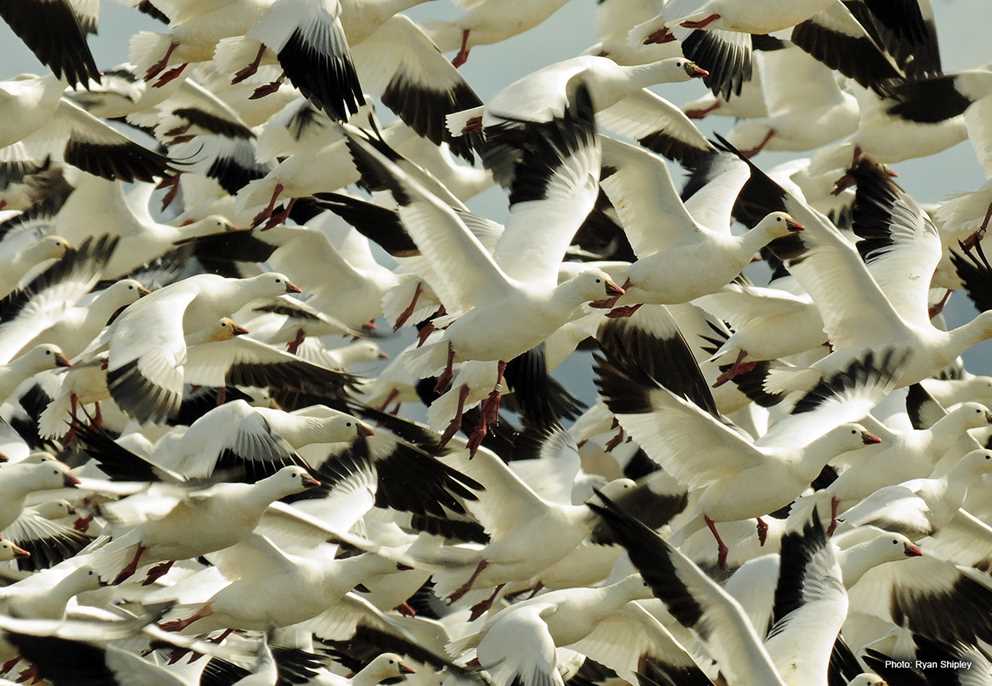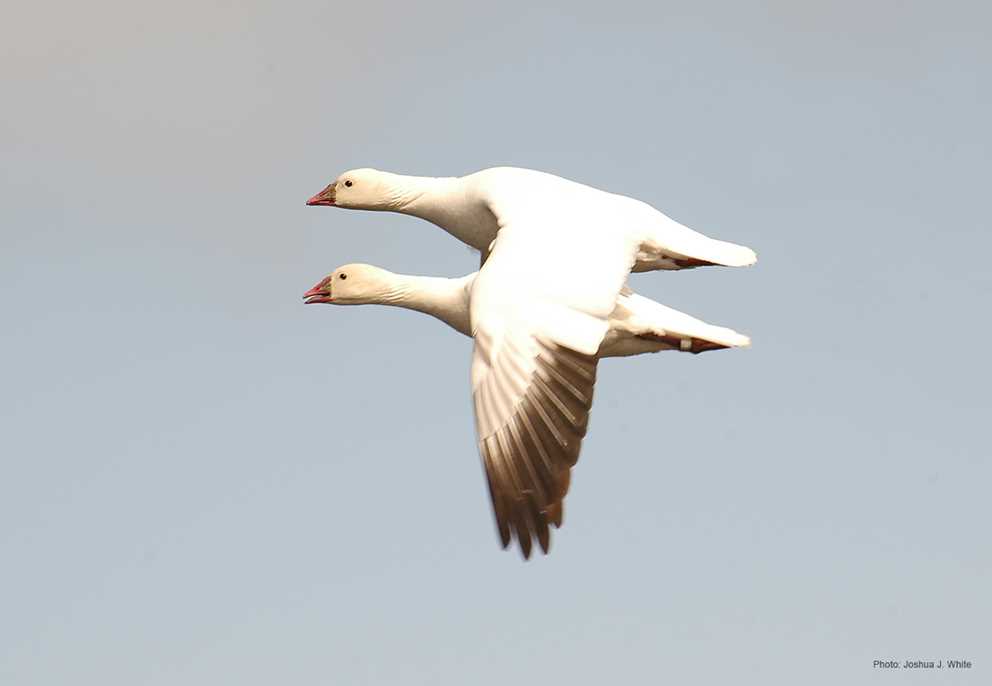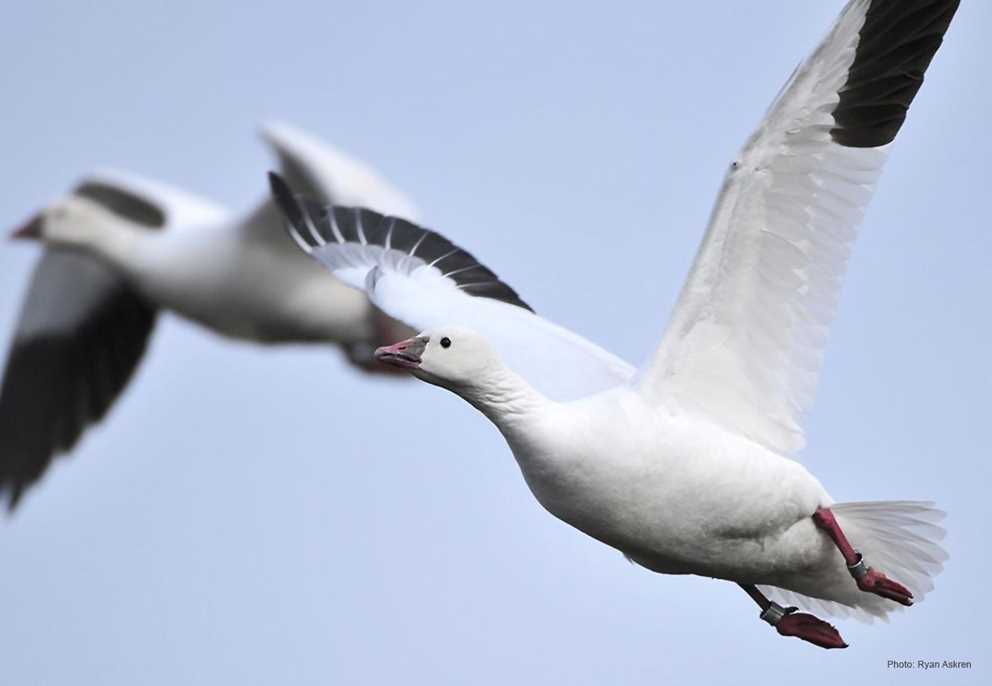Overview
Ross’s Goose range is restricted to North America. Its breeding range extends from Queen Maude Gulf, Northwest Territories, to Baffin Island in the central Arctic, and along the western coast of Hudson Bay. Ross’s Geese winter in the Central Valley, the Central Highlands of Mexico, and the Lower Mississippi Alluvial Valley and Gulf Coast. Ross’s Geese are small with all white plumage except that the primary coverts are gray, and the primary feathers are black. The bill is rose pink, and the feet and legs are deep pink. Immature Ross’s Geese are grayish white, with a darker gray area on the crown to the eye. Dark morph Ross’s Geese are exceedingly rare, but are brownish black, have a white head, secondary feathers that are light gray with dark centers, gray to white abdomen, white rump, with the bill and feet like that of the white morph.
Ross’s Geese breed in colonies, usually among Snow Geese in coastal Arctic areas that are at slightly higher elevation and clear of snow and ice earlier. Winter habitat historically was coastal marshes and some inland marshes that provided plants they graze on. Ross’s Geese have subsequently adapted to agricultural habitats in migration and winter. They use a range of post-harvest waste grains (rice, corn, wheat, peas, barley) and graze leaves and grub for winter cereal roots (wheat, rye, barley). They gather to forage and roost in flocks, often with Snow Geese, at times numbering in the thousands during migration and winter.
Description
Key Identification Features
- Ross’s Geese are small white geese, 60–70% the size of Snow Geese.
- The Ross’s Goose subspecies has two color morphs heavily dominated by the light or white morph with the dark morph being quite rare. The light morph is all white, except for gray primary coverts, and black primaries.
- The bill is rose red and shows no “grin patch” that separates the species from the larger but similar looking Snow Goose. The legs and feet are deep pink.
- The exceedingly rare dark morph has a white head, brownish black neck, back and flank plumage, gray wing coverts, and black primary feathers, light gray belly, and white vent and rump. The bill and feet are like the light phase.
Male/Female Average Length and Weight
- Mass: Males 2.5–4.5 lbs.; Females 1.9–4.5 lbs.
- Wing Length: Males 13.0–15.7 in.; Females 13.8–15.4 in.
Male and Female Identification
- Alternate (Breeding) and Basic Plumage: The Ross’s Goose has a light morph and a rarely encountered dark morph. The light or white morph is all white, except for gray primary coverts, and black primaries. The bill and feet are rose red, with the bill lacking the “grin patch” that separates the species from the smaller but similar looking Ross’s Goose. The exceedingly rare dark morph has a white head and neck, brownish gray body plumage, gray primary wing coverts with black primary feathers, a light gray belly, and gray rump. The bill and feet are like the light phase.
In-flight Identification
- Ross’s Geese have a short neck, black primaries, and gray coverts.
Vocalizations
- Similar but higher pitched than snow geese. In flight, described as “keekkeek keek.”
Similar Species
- Snow Geese: Difficult to separate from Snow Geese at a distance, but Ross’s Geese are 30% smaller and usually lack the grin patch on the bill compared to Snow Geese. The bill appears shorter and stubbier compared to Snow Geese. Blue morph Ross’s Geese are exceedingly rare but may still be separated by size and lack of grin patch on the bill, and the white only occurs on the head, not the head and neck as in Snow Geese.
Habitat Preferences
- Breeding: Ross’s Geese nest in Arctic coastal tundra habitats. They nest in colonies, often associated with Snow Geese, in grassy or rocky areas protected from the wind.
- Migration and Wintering: During migration and winter, Ross’s Geese historically used large coastal and inland marshes but have adapted to large scale agriculture and often use rice, corn, wheat, barley, and pea fields, and pastures extensively. Roosts are large open wetlands, lakes or flooded agricultural fields.
Foraging Habits and Diet
- Ross’s Geese are vegetarian and graze a variety of leaves and roots of sedges, grasses. During migration and winter, they graze on a variety of green vegetation and pick seeds of waste wheat, barley, rice, corn, and peas.
Breeding Habits
- Monogamy: Ross’s Geese maintain monogamous pair bonds, with duration of pair bonds not known but like other geese, they may maintain lifelong pair bonds.
- Nest Locations: The nest is usually a scraped area in grass, with vegetation used to form a bowl.
- Clutch Size: The average clutch size is 2–6 eggs. The eggs are nonglossy white or light cream, sub-elliptical, and average 2.9 by 1.9 in. The incubation period is 22 days, with females performing incubation duties. Males provide nest defense.
Migration & Distribution
- Fall Migration: Migration begins in late August, with most birds arriving on and staying in fall staging areas from September through November, depending on latitude and influenced by weather conditions. Arrival in wintering areas is from October to November.
- Spring Migration: In Spring, birds begin migration in February, arrive and stay in staging areas during March, April, and May, and usually arrive on breeding areas in late May to June.

Conservation Status
- IUCN Status: Least Concern
- Population Status: Recent estimates are 2.35 million birds and an increasing population. During the early 1900s, the population was small and of conservation concern. In the early 1950s there were 2,000–3000 Ross’s Geese, but by 2006 there were 1.3 million birds.
- Conservation Concerns: The primary threats include habitat loss, issues associated with low population numbers (ex. inbreeding), and climate change.
- Conservation Focus: Conservation efforts focus on protecting habitat and maintaining sustainable hunting regulations.
Harvest Information
- An average of 63,825 Ross’s Geese were harvested per season across the US during the 2019 through 2022 hunting seasons.
- Ross’s Goose harvest is typically highest in the Pacific Flyway, accounting for 40 to 50 percent of the total US harvest.
- The top three states for Ross’s Goose harvest, based on annual averages across the 2019–2022 hunting seasons, were California (19,782), Texas (12,710), and Arkansas (5,591).



